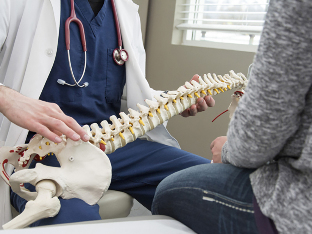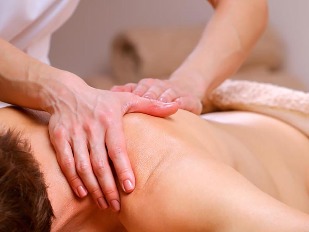With osteochondrosis of the lumbar spine, the symptoms and treatment of the disease will be further discussed, the individual's mobility is limited, the ability to live a normal life. Almost half of the patients complain of pain in this part of the back. According to the results of the poll selection, the osteochondrosis lumbar region is in second place after respiratory diseases.
If until recently age-related degenerative processes were considered the main cause of the pathology, now many more factors that cause the disease have been clarified. Before starting treatment, you need to understand what osteochondrosis of the lumbar spine is.
The disease is a pathological change in the intervertebral discs, accompanied by dystrophy of the ligaments, destruction of the vertebral bodies themselves. It is the lumbar region that suffers the most, as it faces a huge load when lifting weights in a sitting position.
Signs of osteochondrosis of the lumbar spine are becoming more common in young people as young as 30 years old. It is impossible to start the disease, as the complications are fraught with disability, paralysis of the lower extremities.Main Symptoms of Bone Osteochondrosis
Osteochondrosis of the lumbar region is a deformity pathology, which in most cases is a natural aging process. But high physical activity in the spine, metabolic disorders, abuse of harmful products and alcohol accelerate this process.The first signs of pathology do not appear immediately, so treatment is not always started on time. With osteochondrosis of the lumbar spine, the symptoms are as follows:
- pain most often aches in the early stages and acute in 2-3 stages of disease development (with any sudden movements, the discomfort becomes stronger and during bed rest disappears).
- With osteochondrosis, sensations of weakness appear in the legs (reflex tendons are lost in the lower extremities, which is clearly visible during neurological examinations).
- lumbar curvature?
- violation of urination and defecation (depending on where the spinal cord was bitten).

Additional symptoms of lumbar osteochondrosis can also be found: feeling of numbness in the lower back, dryness and flaking of the skin, change in its shade (it turns blue). Sweating increases in the buttocks area. One of the signs of osteochondrosis in men of the lumbar spine is considered erectile dysfunction.
With osteochondrosis of the lumbar spine, the symptoms vary in severity. Some manifestations can be combined in syndromes.
| Συνδρομα | Feature |
| Ischemic | Here, signs of lumbar osteochondrosis appear due to damage to the blood vessels. The arteries begin to spasm (the process becomes permanent over time). This condition is characterized by pain in the muscles of the lower leg and thighs while walking. If the blood vessels sting and break for a long time, then the nutrition of the pelvic organs is disturbed, as well as their function. In women, the pathology causes problems with the menstrual cycle, the ability to conceive a child, urination |
| Vertebral | It is characterized by pain of varying intensity and localization. It occurs after the load on the lumbar spine: bending, lifting heavy objects. If a disc herniation occurs, then the person may lose sensitivity in the legs. In this case, changes occur in the spine: changes in posture, the person relaxes, gait becomes problematic |
| Radial | The vertebrae become unstable, compressing not only the nerve roots but also the blood vessels. One symptom of the syndrome is pain at the point of pinching the limbs. Unpleasant sensations spread to the buttocks and legs. A person has an increase in muscle tone, is forced to change his gait. In the absence of treatment for osteochondrosis, the nerve roots become inflamed. This condition is accompanied by swelling of the tissues of the body that surround the spine. The blood begins to stop, the poisoning process begins. With root syndrome, pain is seen in other joints. In addition to these symptoms, a "goose" sensation appears in the lower back (lower back). In particularly difficult cases, patients can no longer move independently |
People with low back osteochondrosis should have a thorough examination to find out how serious the disease is and to determine the treatment regimen.

Degrees of bone osteochondrosis
Lumbar osteochondrosis develops gradually. There are such stages of pathology development:
- First. In this case, the core of the kernel, which is inside the disk, begins to move and change. Cracks appear in the fibrous ring. Nerve roots are irritated, which is signaled by back pain. At this stage of osteochondrosis, the discomfort is still local, that is, the symptoms are felt only in the area of the damaged disc. Sometimes it is back pain, but in the early stages of development, there is often a constant dull pain. The discomfort in osteochondrosis increases after the load on the lumbar spine.
- Second. This is where the destruction of the fibrous ring occurs. The mobility of the injured vertebrae increases, while the muscle tissue becomes tense. The distance between them is reduced, they can be shifted in relation to each other. It becomes more difficult for a person to move, as he quickly gets tired, feels severe discomfort in the lumbar region. The pain spreads to the thighs, legs, buttocks. The person has increased sweating.
- Third. At this stage of the disease, the pain intensifies many times because the fibrous ring breaks. In this case, the pulposus nucleus leaves its place and a hernia forms. The patient feels acute pain and backache when the tissues and nerve roots are compressed. The discomfort becomes constant and unbearable. The work of the internal organs was stopped.
- Fourth. Deformation of the spine occurs. It is very difficult for a person to move, but the pain symptom becomes less intense. This does not mean that the pathology is no longer developing. This condition is a sign that a person will soon be sitting in a wheelchair. In addition, in the area of the damaged disc, osteophytes develop, worsening the condition even more, the muscle atrophy.
If the development of the disease is not controlled and treatment is not started in time, the vertebrae will collapse and restore them without a dangerous and difficult operation will not work.
What to do in case of worsening of the disease
Osteochondrosis of the lumbar region is a difficult disease that should not be transferred to the last stage. It quickly becomes chronic, and even the most effective treatment can only stop the development of the pathology or slow it down.If severe back pain occurs and a person is unable to move normally, this indicates a worsening of the pathological process. It most often occurs in patients who do not follow the recommendations of doctors. If deterioration has occurred, a person should follow these rules:
- It is best to give up physical activity altogether for the time it will take to restore normal body function. It is better to be in a comfortable position that does not cause discomfort. It is good if the patient uses a hard mattress, as the body in this case (especially the lumbar region) does not hurt.
- To minimize the load on the back, a person can use a semi-rigid corset. It will restrict sudden movements.
- To reduce the severity of osteochondrosis pain, you should slowly bend the leg at the knee on the affected side. This will help relieve muscle tension and relieve nerve tissue.
- In difficult cases, the application tool can be used, but it must be used with caution. The procedure is performed twice a day for 30 minutes.
- After a massage that gradually restores normal blood circulation and muscle tone, you should use an anti-inflammatory ointment.

Warm the affected area on the first day after the onset of deterioration. The dry heat is applied only on the second day, when the pain peak has passed. Otherwise, the swelling of the tissues will increase and the condition of the patient with osteochondrosis will worsen.
Disease Diagnostics
Lumbar osteochondrosis requires a serious approach and complex treatment. It becomes easier for the patient if he takes the right medication, performs the exercises prescribed by the doctor. To choose a treatment regimen, the patient must be examined. The following diagnostic methods stand out:
- X-ray. If the lumbar joints are affected, the x-ray evaluation is considered the main one. The image is taken in various views. In this you can see the damage to the discs, the condition of the spinal canal. Each view must be perpendicular to the previous one.
- MRI or CT. The procedures presented help to more accurately determine the factors that caused the development of osteochondrosis, in which condition are not only the vertebrae, but also the soft tissues, blood vessels, nerve endings. At the same time, the person does not feel any discomfort.
- External examination by palpation of the damaged area and neurological examinations.
Only a thorough diagnosis will determine if a person is actually developing osteochondrosis.
Treatment of lumbar osteochondrosis
If bone osteochondrosis has not been treated, the patient develops complications such as protrusion, vertebral joints, hernia, sciatica, spinal stenosis and pelvic organ dysfunction. The person also begins to bleed, has paralysis and paralysis of the legs.The treatment of lumbar osteochondrosis has many tasks. First, it is necessary to eliminate the inflammation that causes pain in this disease. Of course, you need to stop the unpleasant symptoms themselves, as well as strengthen the muscular corset in the lumbar region, lower extremities.
Treatment should relieve soft tissue swelling and spasm. The patient is prescribed means and procedures designed to improve organ function, regulate blood circulation, restore metabolic processes in the body and also extendof the range of motion. Since osteochondrosis of patients' lumbar spine will be treated for a long time, you should choose these methods that will give a good result and cause minimal harm. Drugs, alternative therapy, physiotherapy, LF and other methods are used.
Surgery
In advanced cases, when the development of the disease has reached its final stage, osteochondrosis of the lumbar region requires surgery. The help of a surgeon is necessary in the presence of complications that affect the function of the organs, a spinal hernia. Emergency surgery is performed if there is a threat of developing paralysis of the lower extremities.
The most effective intervention is to remove the damaged disk. Also common is the microsurgical method of treating osteochondrosis of the lumbar spine with an endoscope. This procedure is less traumatic for the patient and allows him to recover as soon as possible.
Physiotherapy procedures
With lumbar osteochondrosis, the symptoms (treated in different ways) can be eliminated with the help of physiotherapy procedures. Useful:- diadynamic currents?
- electrophoresis and phonophoresis?
- magnetic therapy?
- laser treatment.
Physiotherapy procedures will offer the maximum benefit in combination therapy, in combination with drugs.
Physiotherapy exercises
Treatment of lumbar osteochondrosis will not be effective without performing a set of exercise therapy prescribed by a doctor. All exercises aim to improve the mobility of the lower back, strengthen the muscular corset and increase the stability of the spine. The band must be run regularly.
The doctor usually prescribes the following exercises: bending in different directions, standing, walking on all fours and back, stretching the abdominal muscles in the supine position.

Massage
Can only be performed after elimination of deterioration or during recession. Thanks to the procedure, you can not only relax the spasmodic muscles, but also strengthen them. The massage is more effective after the bath. It should be performed by a specialist, applying the right techniques: stroking, rubbing. The procedure should not be performed if there are open sores on the back, if the person has been diagnosed with dermatological diseases or circulatory problems.
Manual therapy
Manual therapy solves the same tasks as massage, but uses slightly different techniques. You can not trust your spine to an amateur. An experienced process specialist is required, who will not hurt.
Medicines
In the treatment of lumbar spine osteochondrosis, no drugs can be administered. When choosing them, the general condition of the body, the stage of development of the disease is important. To fight osteochondrosis, there are the following most effective groups of drugs:
Analgesics.
- NSAIDs - These drugs eliminate the inflammation and pain that accompanies it. They relieve swelling, normalize body temperature. Muscle relaxants - These medicines are prescribed by a doctor and are only used when NSAIDs have failed. Muscle relaxants help relieve muscle spasms.
- Chondroprotectors-Keep the cartilage in good condition without letting it break. But they are effective only if this layer is not completely erased.
- Steroid anti-inflammatory drugs. They are last appointed in the most advanced cases.
- Multivitamins and B vitamins - The preparations presented help to improve the functionality of the NS.
- Antidepressants (to restore the patient's emotional background). Blocking Novocaine with hydrocortisone. They are placed directly into the part of the back where the pain comes from. Exclusions are rare, as they are capable of causing muscle atrophy.
- Preparations to improve blood circulation and microcirculation.
Topical medicines - ointments - have good efficacy and minimal side effects. If the patient is using folk remedies for treatment, the medication should continue to be taken.
Prevention of osteochondrosis of the lumbar spine
Lumbar osteochondrosis can be prevented by following simple rules of prevention:
- Avoid hypothermia and infection.
- do not lift heavy objects.
- bags worn alternately on both shoulders.
- follow the alcohol consumption regime and eat properly.
- keep your body weight within normal limits.
- early treatment of congenital or acquired skeletal pathologies.
- go for a swim, move more, run a lumbar gym every day.
- undergo regular medical examinations.
Taking care of your own health will help you avoid the complications of lumbar osteochondrosis and there are many of them and they are difficult to treat.

















































